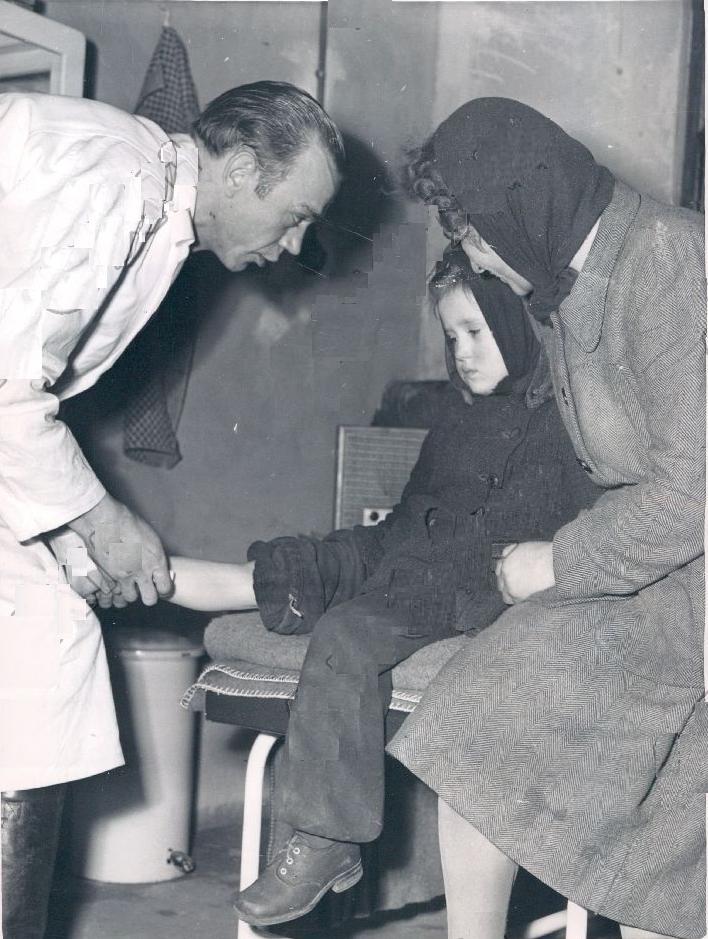
The Cold War: Refugees Fleeing the Communists

Figure 1.--Germans in the Soviet occupation zine had no way to cast ballots, but unlike most people behind the Iron Curtain could vote with their feet. Here are two East Germans that did just that in Berlin. The press caption read, "The tens of thousands of East Germans fleeing to West Berlin are sriouly threatening to swap thatwar-torn city. According to West Berlin's mayor Ernst Reuter, the mass flight from Communism has taken on 'catastrophic proportions.' The refugees are housed mostly in 75 camps, 45 of which have been opened by the Red Cross. Disused factories, bombed out partially repaired buildings and tempoary wooden barracks are used to shelter the bewildered East Germans during their screening, a process which takes four to six week. Overvrowding is acute and growing worse daily." Another paper focused more in the individuals. This caption read, In the first aid station of a refugee camp, a Red Cross worker treats the blistered feet of a young boyafter he and his fmily had trekked from their East German home. The youngster's anxious mother looks on." East Germans beyond Berlin often had to hike to Berlin as their were controls on movement enforced by transit authorities. This created difficulties for familiies desiring to escapewest. The photograph was dated Februry 6, 1953.
|
|
Following World War II and the imposition of the Allied and Soviet occuption zone in Germay and the Soviet creation of Communist police states throughout Eastern Europe movement of people were restrictd. Eastern European Comminists adopted Soviet policirs of preventing the free movement of people across what Churchill described as the Iron Curtain. Stalin found this an effective way of preventing the Soviet population of knowing how bad conditions were in the Soviet Union and creating the fiction in the West that Communism was building a worker's paradie. Eastern European Communists at first did not see this as a problem, really believing that Communism would cretr a stronger economy than in the capitalit West. Berlin was also different. It still functioned as a fairly free city and the movemnt pf pople between occupation zones. The overhead rail system had tops in both Western and Soviet zones. People with suitcases might be stopped by Soviet authoriries, but for the most part people could move freedly, It was the one open chink in the Iron Curtain. And this was not just for Berliners. Berlin like Germny inself was at first subjected to a four-power occupation. Andit was almost entirely a one-way movement, East Germans traveling west. It was the only area of the Iron Curtain where Eastern Europeans could freely leave. And even after the Brlin Crisis (1948-49), the Berlin exit route remained open. Taking advantage of this route, the number of Eastern Europeans applying for political asylum in West Germany was 197,000 (1950), 165,000 (1951), and 182,000 (1952). It should not be thought that political freedom was the primary issue. After the German Economic Miracle began to take hold, substantil differences in living standards began to develop btween East and West Germany. And Germany was unique, not only could the Germans lisren to Radio Free Europe, but they could also listen to commercial broadcasts and the adbertisements for products that the East German economy could not provide.
German Communists finally relized that they could not compete with the West, bit tgere nswr was mo ecomnomic reform but finally closed the border with West Germany (summer 1952). The border in Berlin, however, remained open. East Germans who found t difficult to cross the increasinly hardened border with West Germany could come to Berlin and reach the Western Zone there. As a result of the East German Worker Riots and the prospects for increaed Sovietization eslewhere in Eastern Europe, the number of refugees increased to 331,000 in 1953. [Loescher, p.60] Workers who participated in the riots if they could be identified wee arrested. Some sought to escape to West Berlin. Many who did not participate used the Berlin escape route to reach the west. This began a massive brain drain whivh would not stop until the Berlin Wall was erected (1961).
Sources
Loescher, Gil. The UNHCR and World Politics: A Perilous Path (Oxford University Press, 2001).
CIH

Navigate the Children in History Website:
[Return to Main East German Worker Riots page]
[Return to Main East German Cold War page]
[Return to Main German Cold War page]
[Return to Main Cold War page]
[About Us]
[Activities]
[Chronology]
[Clothing styles]
[Countries]
[Debate]
[Economics]
[Garment]
[Gender]
[Hair]
[History]
[Home trends]
[Literary characters]
[School types]
[Significance]
[Transport and travel
[Uniform regulations]
[Year level]
[Other topics]
[Images]
[Links]
[Registration]
[Tools]
[Return to the Historic Boys' School Home]
Created: 2:00 AM 5/11/2015
Last updated: 2:00 AM 5/11/2015



